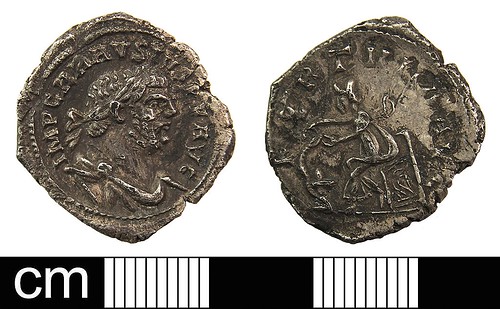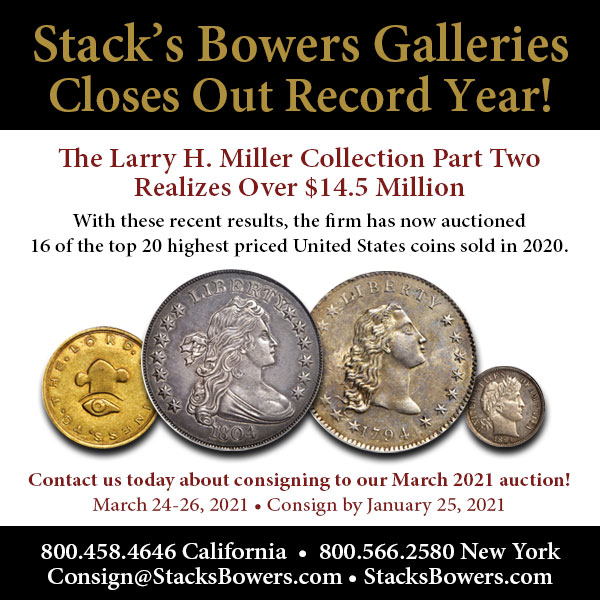
PREV ARTICLE
NEXT ARTICLE
FULL ISSUE
PREV FULL ISSUE
REDISCOVERING OLD PROVENANCES FOR ANCIENT COINSSpeaking of provenances, this week I came across this June 2, 2020 article by Peter K. Tompa on the Cultural Property News site about Dr. Jonas Flueck of Ex-Numis and the use of computer technology to discover images in old auction catalogs. Here's an excerpt - see the complete article online. -Editor 
A Roman coin, Denarius of Carausius, reported to the Portable Antiquities Scheme (PAS) illustrates the irregularities that can most easily enable identification of a specific coin. On May 30, 2020, Dr. Jonas Flueck of Ex-Numis and Lugdunam International Auction House explained his use of facial recognition technology to rediscover old provenances for ancient coins. United States import restrictions imposed on ancient coins, new regulations in Germany and the EU, and claims that terrorists have been selling ancient coins to fund their activities have all made the rediscovery of old provenances more important than before. Dr. Flueck prefaced his talk with a discussion of different types of provenances. Provenance is generally comparable to the concept of chain of custody. The International Association of Dealers in Ancient Art has developed useful concepts to explain different forms of provenance. "Hearsay provenance" is the weakest form of provenance. This is a vague provenance, usually restricted to a date or location. An example is "from an old Swiss collection." The only thing that backs up this provenance is the good faith of the dealer in question. "Named provenance" is somewhat stronger. It is a provenance linked to a specific collection or person. The problem is that this kind of provenance cannot always be verified. The strongest form of provenance is "documented provenance" linked to a specific sale or other documentary material like invoices or export licenses. It is this last, strongest type of provenance which Ex-Numis seeks to reestablish. Until now, dealers and collectors have had to conduct manual searches through hundreds of old auction catalogues to recapture old provenances. Without some suspicion where a coin may have appeared in the past, this is virtually an impossible undertaking. The genius of Dr. Flueck's system is that he has spent considerable time, effort and money scanning thousands of auction catalogues and then applying facial recognition technology to compare coins which are submitted to his service to those in old catalogues in order to recover old provenances. These include some 130,000 coins listed in catalogues pre-dating 1970, the date of the UNESCO Convention. Still, the system has some serious limitations that help explain why the vast majority of coins without a recoverable provenance are not the products of recent, illicit digs. First, before widespread use of digital photography in the 1990's, it was time consuming and difficult to take photographs of coins. For that reason, the vast majority of coins sold at auction or in fixed price lists were not photographed. Second, although Ex-Numis has recently sought to add fix price lists to its database, many of these lists were only produced in small numbers and are no longer easily available today. Lastly, the system does not capture more recent provenances created during the digital era; however, such coins can be found reviewing commercially available databases, like Coin Archives, AC Search, Sixbid Archives or CNG's Research page. Notwithstanding these limitations, when a match is found, it can not only detail lost provenances but whether a coin has been altered over time by cleaning or tooling. It can also provide some assurance that a coin was on the market before the advent of highly sophisticated fakes produced with the use of laser cut coin dies. Conversely, it can prompt concerns about authenticity if a coin was previously withdrawn from auction.
To read the complete article, see:
To read the earlier E-Sylum article, see:

Wayne Homren, Editor The Numismatic Bibliomania Society is a non-profit organization promoting numismatic literature. See our web site at coinbooks.org. To submit items for publication in The E-Sylum, write to the Editor at this address: whomren@gmail.com To subscribe go to: https://my.binhost.com/lists/listinfo/esylum All Rights Reserved. NBS Home Page Contact the NBS webmaster 
|